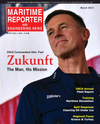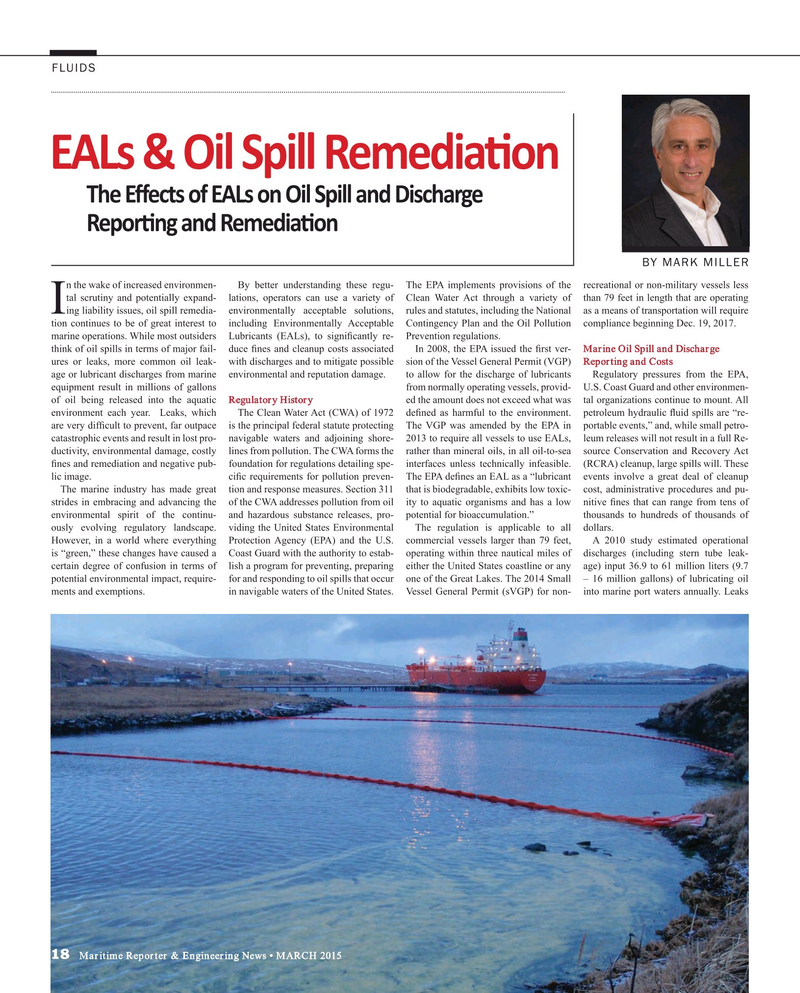
Page 18: of Maritime Reporter Magazine (March 2015)
U.S. Coast Guard Annual
Read this page in Pdf, Flash or Html5 edition of March 2015 Maritime Reporter Magazine
FLUIDS
EALs & Oil Spill Remediat on The E? ects of EALs on Oil Spill and Discharge Report ng and Remediat on
BY MARK MILLER n the wake of increased environmen- By better understanding these regu- The EPA implements provisions of the recreational or non-military vessels less tal scrutiny and potentially expand- lations, operators can use a variety of Clean Water Act through a variety of than 79 feet in length that are operating
Iing liability issues, oil spill remedia- environmentally acceptable solutions, rules and statutes, including the National as a means of transportation will require tion continues to be of great interest to including Environmentally Acceptable Contingency Plan and the Oil Pollution compliance beginning Dec. 19, 2017.
marine operations. While most outsiders Lubricants (EALs), to signi? cantly re- Prevention regulations.
think of oil spills in terms of major fail- duce ? nes and cleanup costs associated In 2008, the EPA issued the ? rst ver- Marine Oil Spill and Discharge ures or leaks, more common oil leak- with discharges and to mitigate possible sion of the Vessel General Permit (VGP) Reporting and Costs age or lubricant discharges from marine environmental and reputation damage. to allow for the discharge of lubricants Regulatory pressures from the EPA, equipment result in millions of gallons from normally operating vessels, provid- U.S. Coast Guard and other environmen- of oil being released into the aquatic Regulatory History ed the amount does not exceed what was tal organizations continue to mount. All environment each year. Leaks, which The Clean Water Act (CWA) of 1972 de? ned as harmful to the environment. petroleum hydraulic ? uid spills are “re- are very dif? cult to prevent, far outpace is the principal federal statute protecting The VGP was amended by the EPA in portable events,” and, while small petro- catastrophic events and result in lost pro- navigable waters and adjoining shore- 2013 to require all vessels to use EALs, leum releases will not result in a full Re- ductivity, environmental damage, costly lines from pollution. The CWA forms the rather than mineral oils, in all oil-to-sea source Conservation and Recovery Act ? nes and remediation and negative pub- foundation for regulations detailing spe- interfaces unless technically infeasible. (RCRA) cleanup, large spills will. These lic image. ci? c requirements for pollution preven- The EPA de? nes an EAL as a “lubricant events involve a great deal of cleanup
The marine industry has made great tion and response measures. Section 311 that is biodegradable, exhibits low toxic- cost, administrative procedures and pu- strides in embracing and advancing the of the CWA addresses pollution from oil ity to aquatic organisms and has a low nitive ? nes that can range from tens of environmental spirit of the continu- and hazardous substance releases, pro- potential for bioaccumulation.” thousands to hundreds of thousands of ously evolving regulatory landscape. viding the United States Environmental The regulation is applicable to all dollars.
However, in a world where everything Protection Agency (EPA) and the U.S. commercial vessels larger than 79 feet, A 2010 study estimated operational is “green,” these changes have caused a Coast Guard with the authority to estab- operating within three nautical miles of discharges (including stern tube leak- certain degree of confusion in terms of lish a program for preventing, preparing either the United States coastline or any age) input 36.9 to 61 million liters (9.7 potential environmental impact, require- for and responding to oil spills that occur one of the Great Lakes. The 2014 Small – 16 million gallons) of lubricating oil ments and exemptions. in navigable waters of the United States. Vessel General Permit (sVGP) for non- into marine port waters annually. Leaks 18 Maritime Reporter & Engineering News • MARCH 2015
MR #3 (18-25).indd 18 MR #3 (18-25).indd 18 3/3/2015 9:46:43 AM3/3/2015 9:46:43 AM

 17
17

 19
19
